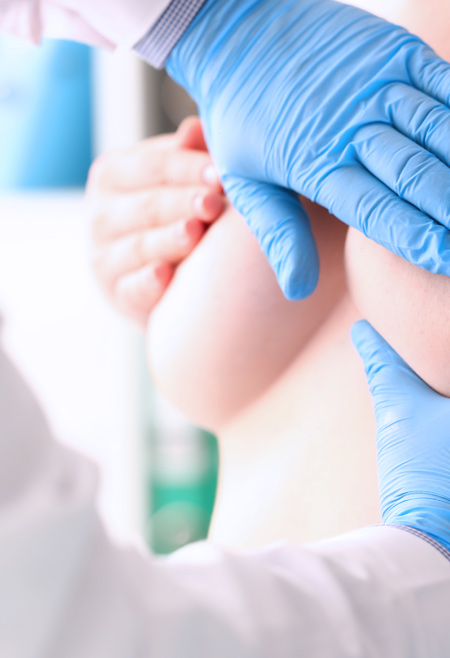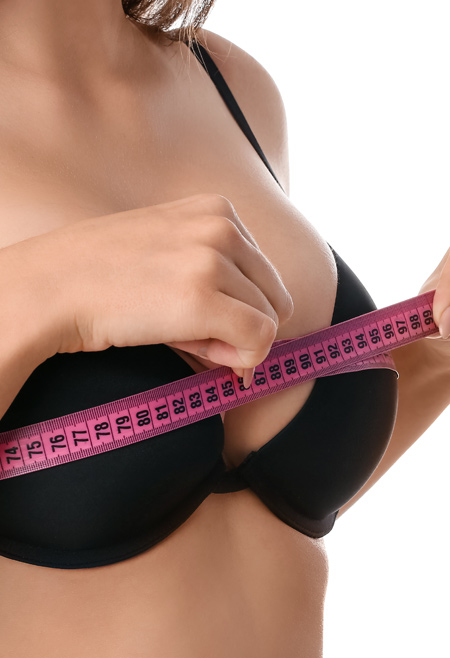Call Us - +(90) 546 776 9042
Some women with overly large breasts discover that their breasts diminish their self-esteem and interfere with their day-to-day activities, which can contribute to a diminished quality of life. This may be due to physical, social, or cosmetic concerns that overly large breasts exacerbate.
Fortunately, breast reduction surgery can reduce large breasts to the size and weight that patients prefer.

What is breast reduction?
This operation is carried out to reduce the size of oversized and saggy breasts by lifting and reshaping them. Besides its aesthetical purposes, this operation influences and improves one’s health, posture and psychology.
+90 546 776 9042Who undergoes breast reduction?
Women over the age of 18 who have completed their breast development and who are suffering from posture imperfections, back and neck aches, bra strap marks and who experience skin problems under and between breasts (rash, eczema etc.) due to large breasts can undergo this operation.


What should be done prior to surgery?
As in all plastic surgeries, the patient should quit smoking minimum two weeks prior to the operation and should also avoid smoking for two weeks after the operation. Anticoagulant drugs, such as Aspirin etc. should be quitted minimum 10 days before the operation. The patient should discontinue any other medication or dietary supplement (medication that include Ginseng, CoQ, Gingko Bloba etc.) 1 week before the surgery. The patient should also disclose any other significant condition to their surgeon.
What is the surgery technique?
The operation takes 2.5 to 3 hours under general anaesthesia. Though it depends on the sagginess of the breasts, incisions are usually made around the nipples, and following a vertical line downwards. The nipple is replaced in an upper position, excessive skin is removed and the remaining breast tissue is reshaped. The surgery leaves scarring in a “lollipop shape” depending on the size of the breast. In very large and loose breasts, upside down “T” shaped incisions can be made to conceal the marks under the lower curve of the breasts. The marks will be slightly red for the first two months. But then, they will come to look like the skin colour, and at the end of the first year they become almost invisible.
What to expect after breast reduction surgery
The operation is generally comfortable for the patients. They can be released from the hospital the following day. The patients do not experience a lot of pain. Supporting bra is worn following discharge and the patients are advised to use them day and night for minimum 3 weeks. They can have a bath after the second day. Patients can resume their works at the end of the first week. Patients should avoid sports activities putting to much pressure on their arms for the first 1.5 months. These are painless operations with highest patient satisfaction. Posture of the patients changes quite visibly after 2 days. They acquire an upright posture and they move freely as they feel lighter. They start to wear tighter clothes that suit them. Breasts are slightly swollen and hard immediately after the surgery. Surgical oedema is the reason for these kinds of complaints. Breasts become softer and find their normal look at the end of the second month.
Important information about breast reduction operation
There will be scarring after breast reduction operation. These marks will look like the skin colour at the end of the first year and become almost invisible. On the other hand, they will never be gone for good.
Thanks to proper techniques, patients can breast feed their babies after breast reduction operations. However, one should keep in mind that some of the milk glands will have to be removed during reduction.
Following breast reduction operation, breasts might get deformed again due to childbirth and excessive weight gain or loss. Yet, they will always look better than their former conditions.
Breast aesthetics correct/ incorrect
All implants used in breast augmentation are FDA approved. No health risks were observed as a result of research on the subject.
Numbness of the nipples can occur after breast augmentation
After research, 90% of patients did not experience a state of numbness. The remaining 9% was due to a mild feeling in the first ten days after surgery. % 1 is due to complications arising from surgery. Therefore the likelihood of loss of feeling after surgery is very low.
All-Inclusive Individual Package
All-Inclusive Individual Package Price includes surgery, medication, support bra, 1 or 2 night hospital stay, 5 nights hotel stay, VIP transfers and an English speaking host.
On the morning of your procedure, you will be picked up by your patient coordinator and transferred to the hospital where you will have a consultation your surgeon. He will assess your chest wall to determine the right implant shape and size for you. Afterwards, you will have medical tests to check your suitability for surgery and once confirmed the procedure will last around 1-2 hours. You will spend the night at the hospital following your surgery.– Day 1
You will be discharged from the hospital in the morning following a check-up by your surgeon. You will be transferred to your hotel where you will continue to rest.– Day 2
You are advised to continue resting, but once you start feeling better you can go out to explore the city on days 5 and 6.– Days 3, 4, 5 & 6
On your last day, you will have a final check-up by your surgeon and you will be ready to go home after receiving instructions on postoperative care. Stitches do not need to be removed as they will dissolve by themselves.– Day 7
Procedure Time
Breast reduction surgery lasts around 2,5-3 hours.
Anaesthetic
Breast reduction surgery is performed under general anaesthesia.
Recovery
The patient can return to work after 1 week.
Frequently Asked Questions
AM I A CANDIDATE FOR BREAST REDUCTION?
If you have large breasts that cause physical and emotional discomfort, you may consider a breast reduction. Large breasts may lead to self-consciousness and low self-esteem. The excess weight may lead to pain and discomfort resulting from the extra pressure on the neck, shoulders, and upper back.
To be a successful candidate for the procedure, you must be in good health, not smoke, have realistic expectations, and show evident signs that your large breasts interfere with your quality of life.
It is required that you stop smoking and taking anti-inflammatory medications and supplements before and after surgery.
HOW IS BREAST REDUCTION PERFORMED?
During your consultation, your surgeon examines your health history and takes photos, x-rays, blood tests, and other tests to ensure you are a candidate for breast reduction. Breast reduction is performed as an outpatient procedure under general anesthesia. The incisions chosen for your breast reduction will depend on the amount of tissue being removed; however, the most common incision is known as the anchor or inverted-T incision.
This incision runs around the areola, vertically down the lower pole of the breast, and horizontally across the breast crease (inframammary fold).
The anchor incision allows for the most significant amount of tissue to be removed and often provides the most natural-looking results (even if it results in post-surgical scarring on the breast). If you desire a lesser degree of reduction, your incisions may be smaller to reduce scarring.
Through these incisions, glandular tissue, fat, and skin is removed to sculpt a smaller, more proportionate breast. The nipple-areola complex can be repositioned or resized if necessary.
Breast reduction is almost always combined with breast lift surgery, which addresses sagging breasts. Some women also choose to combine their breast reduction with liposuction of the surrounding areas.
WHAT SHOULD I EXPECT DURING MY BREAST REDUCTION RECOVERY?
Your incisions will be covered with gauze and your breasts wrapped in a compression garment that will help to reduce swelling, promote circulation, and ensure the breasts heal in their correct placement.
You will probably feel some discomfort and breast tenderness for two to four weeks because of the bruising and swelling. This discomfort can be lessened with prescribed or over-the-counter pain medication.
The recovery time may be between two to six weeks, during which you are advised to reduce their physical activity. You will also be asked to avoid underwire bras for a few months after the procedure, as the wires may irritate the incisions.
It is important to continue to be gentle with your breasts during the recovery period, as they may be tender for some time.
WHAT RESULTS CAN I EXPECT FROM MY BREAST REDUCTION?
Much of the swelling and bruising will subside within the first two weeks, and you will start to see your final results.
After your breast reduction, you will feel lighter, your breasts will be smaller, and breast-related back, shoulder, and neck pains will lessen—if not disappear. Additionally, your self-image will improve, as will your aesthetic appearance.

